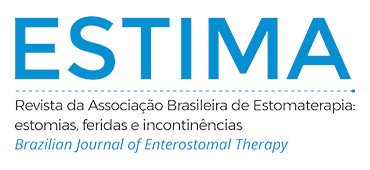EFEITO DA TELE-ENFERMAGEM NO PROCESSO ADAPTATIVO DE PESSOAS COM ESTOMIA INTESTINAL: ENSAIO CLÍNICO
Resumo
Objetivo: Analisar o efeito da tele-enfermagem no processo adaptativo de pessoas com estomia intestinal. Método: Ensaio clínico randomizado, unicego. Aplicou-se a escala de verificação do nível de adaptação da pessoa com estomia, e formaram-se dois grupos. O grupo controle recebeu atendimento convencional com profissionais do centro de referência, e o grupo intervenção obteve o acompanhamento convencional associado à intervenção complementar via telefone (três chamadas telefônicas realizadas no 20o, 40o e 60o dia após contato inicial). Ao final da intervenção, os participantes foram avaliados novamente pela escala. O recrutamento ocorreu desde o primeiro contato e contou com uma amostra de 16 participantes no grupo intervenção e 17 no grupo controle. Resultados: Notou-se semelhança nos níveis de adaptação no baseline entre os dois grupos, entretanto dados do pós-intervenção demonstraram diferença significante dos grupos no decorrer do estudo e menores valores dasmédias do grupo controle comparados às medidas do grupo intervenção, indicando maior nível de adaptação no grupo intervenção. Conclusão: O estudo verificou o efeito da tele-enfermagem no processo adaptativo da pessoa com estomia e sugere benefícios no acompanhamento complementar via tele-enfermagem no nível de adaptação de pessoas com estomia de tempo ≤ 12 meses de cirurgia.
Downloads
Métricas
Referências
Ganjalikhani MK, Tirgari B, Rashtabadi OR, Shahesmaeili A. Studying the effect of structured ostomy care training on quality of life and anxiety of patients with permanent ostomy. Int Wound J. 2019;16(6):1383-90. https://doi.org/10.1111/iwj.13201
Silva AL, Vieira ABD, Moraes RHG, Mazoni SR, Kamada I. Subjectivities and challenges of people living with an intestinal ostomy. ESTIMA, Braz. J. Enterostomal Ther. 2021;19:e1721. https://doi.org/10.30886/estima.v19.1034_IN
Roy C, Andrews HA. Teoria da enfermagem: o modelo de adaptação de Roy. Piaget; 2001.
Marques ADB, Amorim RF, Landim FLP, Moreira TMM, Branco JGO, Morais PB, Santos ZMSA. Body consciousness of people with intestinal stomach: A phenomenological study. Rev Bras Enferm. 2018;71(2):391-7. https://doi.org/10.1590/0034-7167-2016-0666
Sun V, Ercolano E, Mccorkle R, Grant M, Wendel CS, Tallman NJ, et al. Ostomy telehealth for cancer survivors: Design of the ostomy self-management training (OSMT) randomized trial. Contemp Clin Trials. 2018;64:167-72. https://doi.org/10.1016/j.cct.2017.10.008
Cofen. Decreto no 696/2022. Dispõe sobre a atuação da Enfermagem na Saúde Digital, normatizando a Telenfermagem. Cofen;2022.
Kristová J, Bachratá Z, Slezáková Z, Miklovičová E. Implementation of telenursing in the Slovak Republic. Pielęgniarstwo XXI Wieku. 2021;20(3):216-20. https://doi.org/10.2478/pielxxiw-2021-0028
Santana RF, Pereira SK, Carmo TGD, Freire VECDS, Soares TDS, Amaral DMD, Vaqueiro RD. Effectiveness of a telephone follow-up nursing intervention in postsurgical patients. Int J Nurs Pract .2018;24(4):e12648. https://doi.org/10.1111/ijn.12648
França AC, Rodrigues AB, Aguiar MIF, Silva RA, Freitas FMC, Melo GAA. Telenursing for the control of chemotherapy-induced nausea and vomiting: a randomized clinical trial. Texto Contexto Enferm. 2019;28:e20180404. https://doi.org/10.1590/1980-265x-tce-2018-0404
Jiménez PQ, Juan CP, Herrero IP, López CP, Fuentes MG, Casaseca CM, Romaguera AR, Valentí MT, Garcia-Alamino JM, Espirac B, Grupo Cooperativo Estudio Calidad de Vida. A prospective, longitudinal, multicenter, cohort quality-of-life evaluation of an intensive follow-up program for patients with a stoma. Ostomy Wound Manage. 2010;56(5):44-52.
Xavier SSM. Validação da escala de verificação do nível de adaptação da pessoa com estomia (ENAE) elaborada à luz do modelo de Roy [tese de doutorado online]. Natal: Universidade Federal do Rio Grande do Norte; 2018 [acessado em 16 jan. 2023]. Disponível em: https://repositorio.ufrn.br/jspui/handle/123456789/25468
Medeiros LP, Xavier SSM, Freitas LS, Silva IP, Brito do O L, Lucena SKP, Silva RA, Costa IKF. Construction and validity of the adaptation level scale of the person with ostomy. ESTIMA, Braz. J. Enterostomal Ther. 2022;16:e0822. https://doi.org/10.30886/estima.v20.1191_IN
Reis BL, Brandão ES, Tonole R, Moraes EB. Difficulties presented by people with intestinal stoma during self-care: integrative review. Res Soc Dev. 2020;9(11):e55891110183. https://doi.org/10.33448/rsd-v9i11.10183
Ribeiro WA, Andrade M. Perspectiva do paciente estomizado intestinal frente a implementação do autocuidado. Rev Pró-UniverSUS. 2020;11(1):6-13. https://doi.org/10.21727/rpu.v11i1.2214
Selau CM, Limberger LB, Silva MEN, Pereira AD, Oliveira FS, Margutti KMM. Perception of patients with intestinal ostomy in relation to nutritional and lifestyle changes. Texto Contexto Enferm. 2019;28:e20180156. https://doi.org/10.1590/1980-265X-TCE-2018-0156
Valau Júnior CAD, Simon BS, Garcia RP, Dalmolin A, Stamm B, Harter J. Perfil sociodemográfico e práticas de autocuidado desenvolvidas por pessoas com estomia intestinal de eliminação. Braz J Develop. 2020;6(6):41030-47. https://doi.org/10.34117/bjdv6n6-588
Sasaki VDM, Teles AAS, Silva NM, Russo TMS, Pantoni LA, Aguiar JC, Sonobe HM. Self-care of people with intestinal ostomy: beyond the procedural towards rehabilitation. Rev Bras Enferm. 2021;74(1):e20200088. https://doi.org/10.1590/0034-7167-2020-0088
Diniz IV, Alves KL, Sá CM, Almeida AM, Silva RA, Soares SHO, Soares MJGO. Adaptive responses of colostomy patients before and after using an occlude. Acta Paul Enferm. 2022;35:eAPE01917. https://doi.org/10.37689/acta-ape/2022AO019177
Hoppe ADS, Paczek RS, Pagliarini AM, Tanaka AKNSDR, Micheletti VCD, Lana LD. Irrigação de colostomia: impacto na qualidade de vida. Saúde Coletiva. 2021;11(69):8286-95. https://doi.org/10.36489/saudecoletiva.2021v11i69p8286-8295
Santos FS, Vicente NG, Bracarense CF, Dal-Poggeto MT, Goulart BF, Rodrigues LR. Perception of spouses of people with intestinal ostomy on the sexuality of the couple. REME Rev Min Enferm. 2019;23:e-1217. https://doi.org/10.5935/1415-2762.20190065
Santos LCA, Ribeiro WA, Oliveira CR, Guedes CM, Teixeira JM, Cirino HP, Morais MC, Castro K. The person with intestinal ostomy and the return to work activities: a reflective study from the perspective of worker health. Res Soc Dev. 2022;11(11):e158111133541.https://doi.org/10.33448/rsd-v11i11.33541
Ribeiro WA, Andrade M, Fassarella BPA, Flach DMAM, Teixeira JM, Renauro KCDSS. Patients’ profile of the stomized person health care nucleus: in sociocultural and economic optics. Rev Nursing. 2019;22(251):2868-74. https://doi.org/10.36489/nursing.2019v22i251p2868-2874
Lira JAC, Bezerra SMG, Oliveira AC, Rocha DM, Silva JS, Nogueira LT. Collection and adjuvant equipment costs in patients with elimination ostomy. REME Rev Min Enferm. 2019;23:e-1163. https://doi.org/10.5935/1415-2762.20190011
Byfield D. The lived experiences of persons with ostomies attending a support group: a qualitative study. J Wound Ostomy Continence Nurs. 2020;47(5):489-95. https://doi.org/10.1097/WON.0000000000000696
Downloads
Publicado
Versões
- 2023-09-05 (2)
- 2023-08-30 (1)
Como Citar
Edição
Seção
Licença
Copyright (c) 2023 Luana Souza Freitas, Isabelle Pereira da Silva, Julliana Fernandes de Sena, Lorena Brito do O', Breno Wagner Araújo Cosme da Silva, Iraktania Vitorino Diniz, Vera Lúcia Conceição de Gouveia Santos, Isabelle Katherinne Fernandes Costa

Este trabalho está licenciado sob uma licença Creative Commons Attribution 4.0 International License.

























